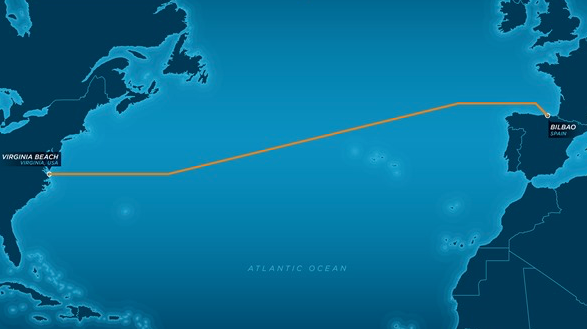Transatlantic Cable To Boost Cloud Services

A new undersea fiber cable with an initial estimated capacity of 160 terabits per second announced this week by Facebook and Microsoft is billed as the first to connect the U.S. with southern Europe as demand for high-speed connections to cloud and online services soars.
The partners said this week they would begin construction of the 6,000 km (4,100 mile) cable system in August, with completion of the construction phase expected in October 2017. When completed, the submarine cable dubbed Marea—Spanish for "tide"—will link a telecommunications infrastructure company formed by Spain's Telefonica with a data hub in northern Virginia.
The undersea cable will extend from Bilbao, Spain, to Virginia Beach, Va. The Telefonica facility in Bilbao, Spain, will then connect network hubs across Europe, Africa, the Middle East and Asia, the partners said.

Route of new Microsoft-Facebook undersea fiber cable. Source: Microsoft
Facebook (NASDAQ: FB) and Microsoft (NASDAQ: MSFT) described the new cable design as consisting of eight fiber pairs, making Marea the highest capacity underwater cable ever to cross the Atlantic. An "open" design would allow the new cable to be interoperable with a range of networking equipment. The result would be "lower costs and easier equipment upgrades which leads to faster growth in bandwidth rates since the system can evolve at the pace of optical technology innovation," the partners stressed in announcing the project.
Telxius, Telefonica's telecommunications infrastructure company, will operate the new cable system and sell capacity as part of its infrastructure business.
Marea's initial capacity of 160 Tbps represents a huge leap over existing transatlantic cables. By comparison, a subsea cable dubbed AEConnect connecting Long Island, NY, to Ireland that began operating in January delivers 13 Tbps per fiber pair.
By connecting with southern Europe, the Facebook-Microsoft project also targets underserved regions. Most transatlantic cables cross between eastern Canada and New England and terminate in the U.K. or northern Europe. Few if any have the capacity of the Marea cable.
Microsoft said the new high-speed, low latency connection would help it meet growing demand for its Azure cloud services. "We are continuing to invest in new and innovative ways to continuously upgrade both the Microsoft Cloud and the global Internet infrastructure," Frank Rey, director of Microsoft's global network acquisition unit, noted in a blog post. "This marks an important new step in building the next generation infrastructure of the Internet."
Microsoft also noted that the southerly transatlantic route physically separates the Marea cable from undersea cables landing primary in the New York metropolitan area. That would help ensure "more resilient and reliable connections," the company noted.
The cost of the project and the terms of the Facebook-Microsoft partnership were not disclosed.
Other proposals to extend cloud and Internet connectivity to underserved regions have so far failed to get off the ground. Google (NASDAQ: GOOGL) has proposed using balloons to provide Internet access while other entrepreneurs have pitched space-based systems.
However, Facebook and Microsoft are betting that evolving optical network technology will allow them to scale the Marea cable well beyond its initial capacity of 160 Tbps.
Related
George Leopold has written about science and technology for more than 30 years, focusing on electronics and aerospace technology. He previously served as executive editor of Electronic Engineering Times. Leopold is the author of "Calculated Risk: The Supersonic Life and Times of Gus Grissom" (Purdue University Press, 2016).











